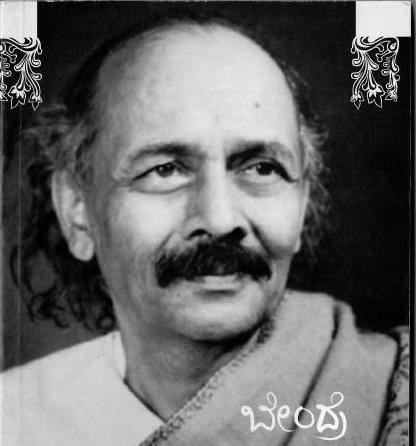This is an interesting poem, made more interesting when one realizes that it is also among Bendre’s earliest. Bendre has written that ತುತೂರಿ (tutoori: ~ trumpet) was his first work, but the book I have says this poem was written sometime between 1914 and 1918 (when Bendre was between 18 and 22 years old). In any case, it seems fair to call this one of Bendre’s “early poems” (when, one can surmise, the Ambikatanayadatta within him had only just begun to come into its own.)
Currently, the poem acts as the prologue to the collection ಮೂರ್ತಿ (moorti: ~ idol), a set of poems that together narrate the rise, the life, and decline of a stone idol. (Incidentally, his poem ‘Sorcerer (ಗಾರುಡಿಗ)‘ serves as the epilogue.)
However, the (somewhat fuzzy) details regarding the poem’s “date-of-creation” leads me to conclude the poem was written separately and is likely one of Bendre’s early experiments with the Petrarchan sonnet form – which experiments would culminate in the harvest of oct-sestets of “ಉಯ್ಯಾಲೆ” (uyyaale: the swing), Bendre’s 1938 collection of poems. In other words, my guess is that the poem was not written as a prologue so much as it was retroactively attached as a prologue on account of its fitting the theme “ಮೂರ್ತಿ” expatiates upon. The same argument can be made about the poem ‘Sorcerer (ಗಾರುಡಿಗ)‘.
In any case, these are minor details and do not – in the larger picture – add to or take away from the poem.
Note: The idea of ಪ್ರಳಯ (praḷaya: ~ dissolution) and ಸೃಷ್ಟಿ (srishṭi: ~ creation) is an important idea in the Hindu (cosmological) imagination. For the interested, the afterword offers (a little) more detail.
Recitation of the Kannada original:
Dissolution – Creation (ಪ್ರಳಯ – ಸೃಷ್ಟಿ)
Like a cloud of smoke that scattering disappears,
the remembered form dissolves; a pall begins
to rise and spread; like form is lost within
a dream, a formless darkness fills all space;
the mind is dense and thick, and time itself
is lost, unknowable; unmoving, the
mind has turned upon itself; what world is
this that lies ahead? An uncreating
sight, a picture! Unpicture. Do I exist?
What else exists? A spreading moor of silence!
Like a deadened body gaining breath, the
darkness around responds; born of the
holy river stone, the melody of Krishna’s
flute is making every fibre of the body
dance; it wears a peacock’s mask. And every-
where are eyes on eyes! Like the widower
given back his bride, the mind is a happy home.
Recitation of the English translation:
(Translated by Madhav Ajjampur)
Poem Details: From the collection “ಮೂರ್ತಿ”, first published in 1934.
Afterword:
Ancient Hindu mytho-cosmology posits a cyclical model of the universe. This is expressed by the term ಕಾಲಚಕ್ರ (kaalachakra: the wheel-of-time) – a notion that imputes an end to every beginning and a beginning to every end. In particular, this cosmology speaks of the cyclical recurrence of four yugas (or ages or epochs): the Krita (or Satya) yuga, the Trēta yuga, the Dvaapara yuga, and the Kali yuga. The belief is that dharma (~right conduct) decreases in each succeeding age. At its zenith in the Krita yuga, dharma continues to dwindle until it reaches its nadir in the Kali yuga. This event necessitates the pralaya (~the reabsorption; the dissolution) of the universe and its subsequent srishṭi (~creation, emergence).
The cycle of pralaya-srishṭi is ceaseless. That is to say, pralaya and srishṭi are attached in the same way as the front and back of a coin. Or, put differently, dissolution and creation are inextricably linked – each succeeds and precedes the other through a spacetime of eternity.
*****
NOTE:
Dear Reader,
If you have enjoyed this translation and the recitations, I hope you will consider buying my recently-released book (!) of English translations of selected Bendre poems. The book is titled The Pollen Waits On Tiptoe. If you are living in India, you can buy the book by going to this page.
THREE IMPORTANT MATTERS:
1. If you are living abroad, you will, unfortunately, not be allowed to buy the book on Amazon India. Therefore, if you would like one or more copies of the book, please write directly to me (mk.ajjampur@gmail.com) with your details.
2. Buying 10 or more books will entitle you an overall discount of 30%. To avail yourself of this discount, contact MUP directly at mup@manipal.edu.
3. The book is also available as an ebook. The app hosting the ebook is called VIVIDLIPI and the book can be purchased at this link. (Since the publisher does not have an agreement with Amazon, I am afraid the book is not available on Kindle.)
